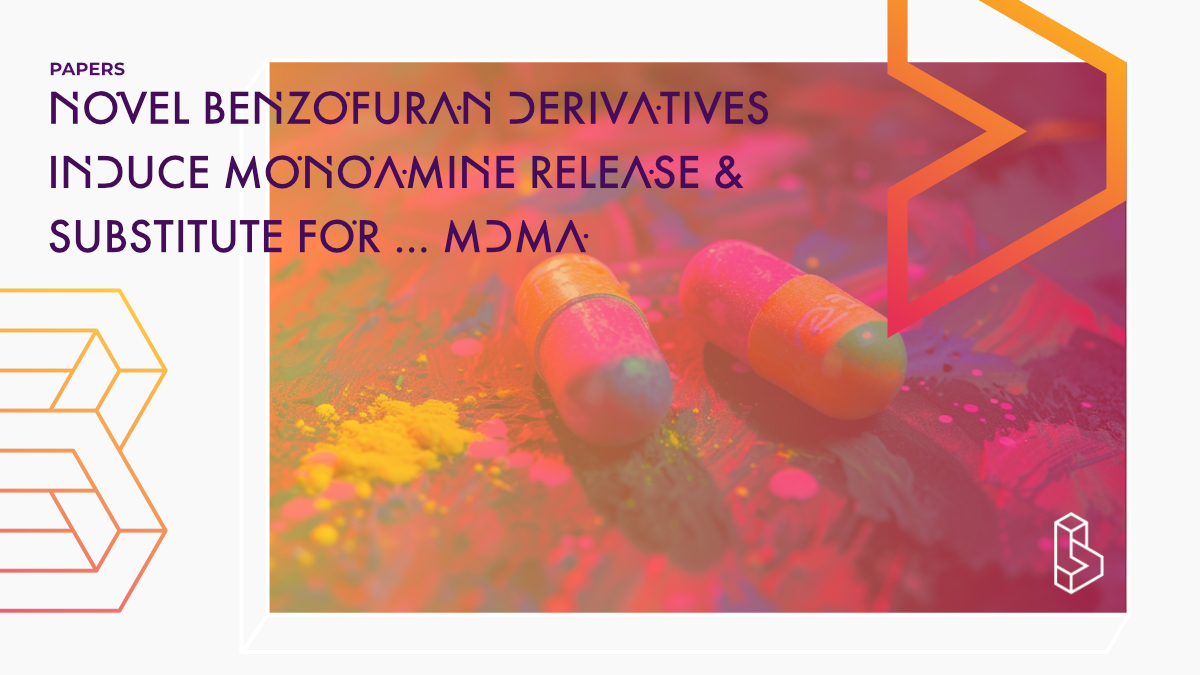This in vitro and in vivo study investigates novel analogues of the designer drug 5-(2-methylaminopropyl) benzofuran (5-MAPB) as potential MDMA-like monoamine releasers. The research reveals that the S isomers of 5- and 6-(2-methylaminobutyl)benzofuran (5-MABB and 6-MABB) exhibit efficacy as releasing agents for serotonin, norepinephrine, and dopamine transporters. In contrast, the R isomers show reduced potency in inducing behavioural effects, suggesting the aminoalkyl benzofuran scaffold is a potential template for developing compounds with MDMA-like properties.
Abstract of Novel Benzofuran Derivatives Induce Monoamine Release and Substitute for the Discriminative Stimulus Effects of 3,4-Methylenedioxymethamphetamine
“3,4-Methylenedioxymethamphetamine (MDMA) has shown efficacy as a medication adjunct for treating post-traumatic stress disorder (PTSD). However, MDMA is also used in non-medical contexts that pose risk for cardiovascular and neurological complications. It is well established that MDMA exerts its effects by stimulating transporter-mediated release of the monoamines, 5‑hydroxytryptamine (5-HT), norepinephrine, and dopamine. Current research efforts are aimed at developing MDMA-like monoamine releasers with better efficacy and safety profiles. To this end, we investigated neurochemical and behavioral effects of novel analogs of the designer drug, 5-(2-methylaminopropyl)benzofuran (5-MAPB). We used in vitro transporter assays in rat brain synaptosomes to examine transmitter uptake inhibition and releasing properties for enantiomers of 5-(2-methylaminobutyl)benzofuran (5-MABB) and 6-(2-methylaminobutyl)benzofuran (6-MABB) as compared to MDMA. We then tested these same compounds in male Sprague-Dawley rats trained to discriminate MDMA (1.5 mg/kg) from saline. In vitro results revealed that S isomers of 5- and 6-MABB are efficacious releasing agents at transporters for 5-HT (SERT), norepinephrine (NET), and dopamine (DAT). By contrast, R isomers are efficacious releasers at SERT, partial releasers at NET, but lack releasing activity at DAT. In vivo results showed that all compounds produce dose-dependent increases in MDMA-lever responding and full substitution at the highest dose tested. The diminished NET and DAT releasing activities for R isomers of 5- and 6-MABB are associated with reduced potency for inducing behavioral effects. Collectively, these findings indicate that the aminoalkyl benzofuran scaffold may be a viable template for developing compounds with MDMA-like properties.”
Authors: Candace B. Johnson, Donna Walther, Matthew J. Baggott, Lisa E. Baker & Michael H. Baumann
Summary of Novel Benzofuran Derivatives Induce Monoamine Release and Substitute for the Discriminative Stimulus Effects of 3,4-Methylenedioxymethamphetamine
Introduction
A phenethylamine derivative, 3,4-Methylenedioxymethamphetamine (MDMA), also known as “Ecstasy”, is used in the treatment of post-traumatic stress disorder (PTSD). Its increased empathy and pro-social effects reduce anxiety and facilitate conversation, which helps patients to confront traumatic experiences. Though clinical outcomes with MDMA are promising, there remains cause for concern.
Prolonged non-medical use of MDMA can induce altered 5-hydroxytryptamine receptor densities and 5-HT depletions in the brain, as well as elevations in blood pressure, heart rate, and stress hormones. MDMA interacts with monoamine transporter proteins expressed on nerve cells to stimulate release of 5-HT, norepinephrine, and dopamine. Aminoalkyl benzofuran derivatives such as 5-APB and 5-MAPB act as transporter substrates analogous to MDMA, and elevate extracellular 5-HT and dopamine in rodent brain.
The authors examined the pharmacology of novel derivatives of 5-MAPB and its positional isomer 6-(2-methylaminopropyl)benzofuran (6-MAPB) using in vitro transporter assays and in vivo drug discrimination methods. They hypothesized that the increased alpha-carbon chain lengths would produce 5-HT releasers with reduced activity at NET and DAT.
Find this paper
https://doi.org/10.1124/jpet.123.001837
Open Access | Google Scholar | Backup | 🕊
Cite this paper (APA)
Johnson, C. B., Walther, D., Baggott, M. J., Baker, L. E., & Baumann, M. H. (2024). Novel Benzofuran Derivatives Induce Monoamine Release and Substitute for the Discriminative Stimulus Effects of 3, 4-Methylenedioxymethamphetamine. Journal of Pharmacology and Experimental Therapeutics.
Study details
Compounds studied
MDMA

